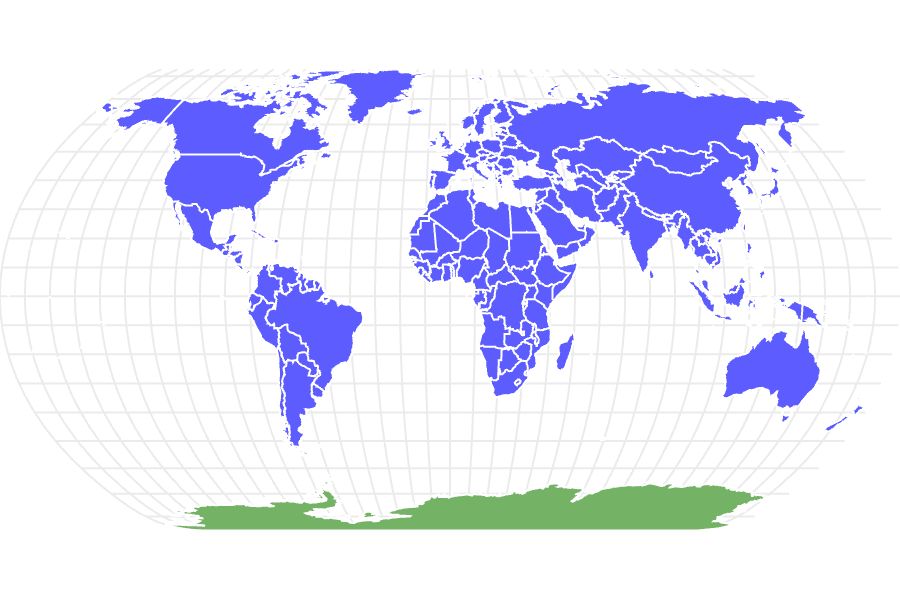Leech
Has 10 pairs of eyes!
Advertisement
Leech Scientific Classification
Read our Complete Guide to Classification of Animals.
Leech Conservation Status
Leech Facts
- Prey
- Fish, insects, mammals
- Name Of Young
- Leech
- Group Behavior
- Solitary
- Fun Fact
- Has 10 pairs of eyes!
- Estimated Population Size
- Unknown
- Biggest Threat
- Predators
- Most Distinctive Feature
- Two suckers on one end
- Gestation Period
- 7 to 9 months
- Litter Size
- 3 to 100
- Habitat
- Typically freshwater ponds and lakes
- Predators
- Fish
- Diet
- Carnivore
- Type
- Invertebrate
- Common Name
- Leech
- Number Of Species
- 680
- Location
- Worldwide
The leech (Hirudinea) is a predator and blood-sucking parasite that is native to almost every continent. This aquatic worm is a member of the Annelida phylum, which means it’s related to the earthworm.
Leeches have a bad reputation among humans. We consider them bloodsucking pests and use the term “leech” as an insult. Most of them don’t attack humans, however, and many don’t depend on blood as their main diet. In ancient times, they were used medicinally. Today, doctors use medical leeches to clean delicate tissue during surgery.
Have you ever been out hiking in a damp area, or gone fishing in some wetlands, and later that day discovered a leech attached to your lower leg? It would leave more than a couple of folks screaming for help, while others may just shrug it off–then pull it off. So how would you wind up with a leech attached to one of your extremities in the first place? Where do leeches live? Read on to learn more about these intriguing invertebrates, including the answer to that burning question.
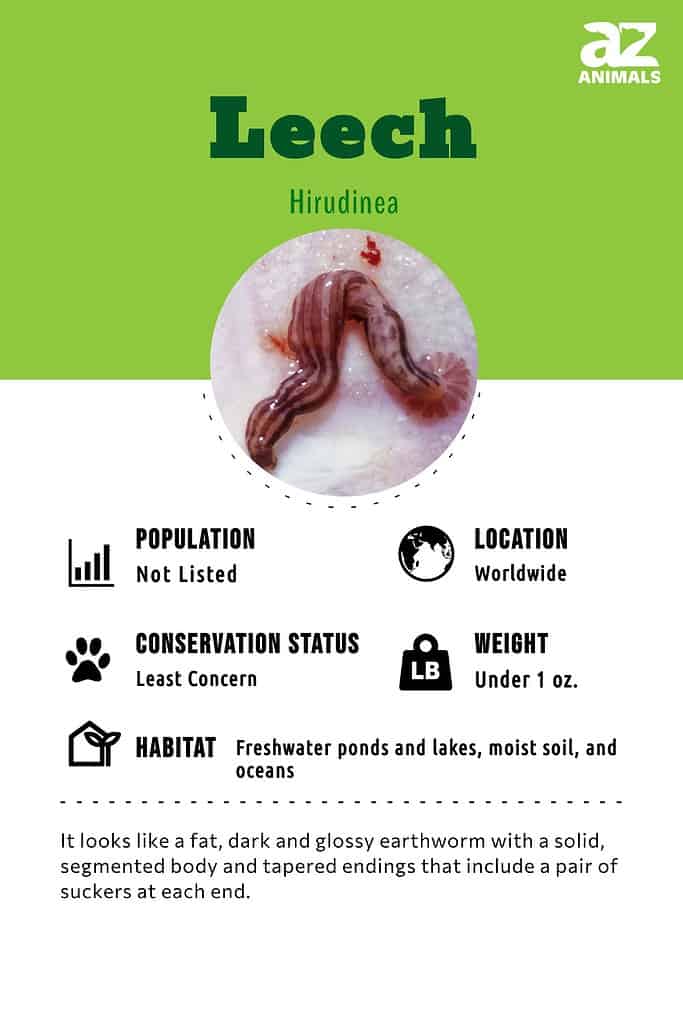
5 Amazing Leeches Facts!
- They have 10 eyes, but they have poor eyesight.
- They can go 6 months without feeding.
- Leeches live in every continent except Antarctica.
- Some people use them as fishing bait.
- Leech therapy is an accepted medical practice.
Scientific Name
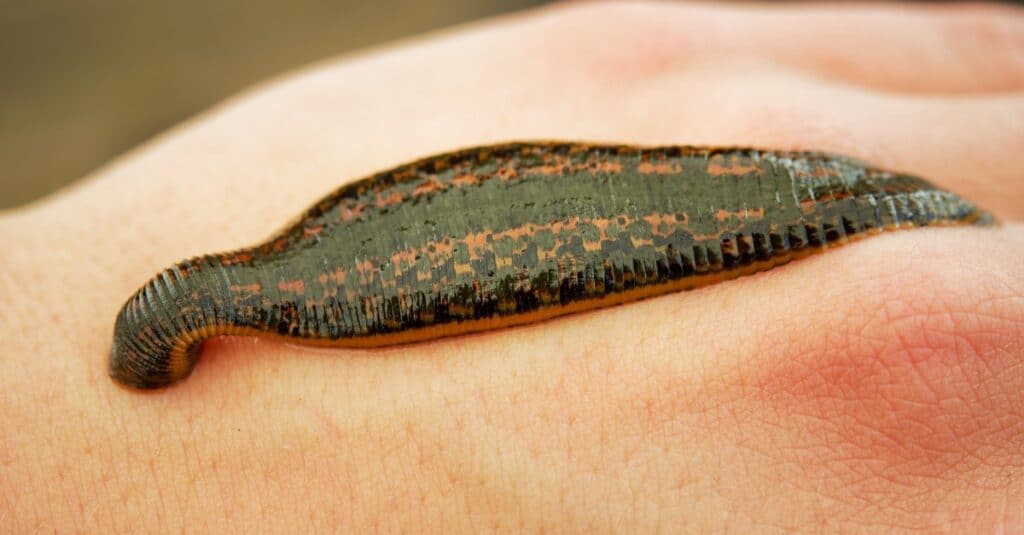
The scientific name, Hirudinea, comes from the word hirudin.
©Martin Pelanek/Shutterstock.com
The leech’s scientific name is Hirudinea. There are over 680 different species or types of leeches. Of these, 100 are saltwater leeches, 480 are freshwater and the rest live on land. Land-dwelling leeches usually live on the banks of ponds and lakes. They are invertebrates that are members of the Annelida phylum, which is the phylum that includes earthworms.
The scientific name comes from the word hirudin. Hirudin is a naturally occurring peptide in the salivary glands of bloodsucking leeches that prevents blood clotting.
Types of Leeches
- Kinabalu Giant Red Leech – The Kinabalu Giant Red Leech definitely lives up to its name. This insect is bright reddish-orange in color and is twenty or more inches long. It’s found on a mountain in Borneo. Kinabalu giant red leeches are carnivores eating a worm that lives alongside it in Borneo.
- Piscicola geometra – These leeches can be found in freshwaters of North America and northwestern areas of Europe, in both stagnate and fast-moving water. They do prefer highly-oxygenated waters.
- Hirudo medicinalis – These types of leeches are known as “medical leeches” and can consume ten times their body weight in blood. They have a thin red stripe on is back side.
- Americobdella Valdiviana – The Americobdella valdiviana can be found in South America, particularly in Chile. Its presence of eyes is up for debate, and this leech has yellow front area and grey back side.
Appearance
A leech looks like a fat, dark, and glossy earthworm. It has a solid, segmented body with tapered endings that include a pair of suckers at each end. The leech uses its suction cups to attach itself to the skin of an animal and suck its blood.
A leech typically has two or three rows of tiny teeth. The small size of these teeth is part of the reason you can’t feel a leech bite.
The leech’s body is usually a dark, greenish-brown color with no spots or stripes. Some are so dark that they look black. Leeches vary in size, but a typical one is 2 inches long. The largest leech species is the giant Amazon leech (Haementeria ghilianii), which can grow 18 inches long and 4 inches wide.

The leech’s body is usually a dark, greenish-brown color with no spots or stripes.
©Ronald Shimek/Shutterstock.com
Behavior
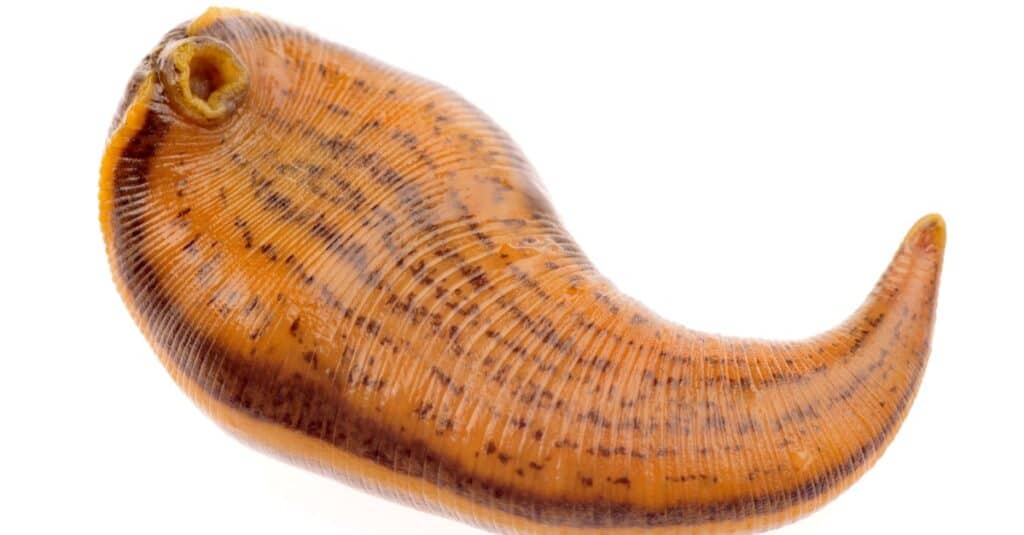
Leeches’ saliva includes an anticoagulant, which keeps the blood of their prey flowing when they bite, and an anesthetic, which prevents their prey from feeling the bite.
©pan demin/Shutterstock.com
Leeches usually inhabit in lakes and ponds, and move slowly through the water in search of food. They don’t form complex societies, but they can usually be found in groups together.
Some types of leeches are parasites and predators. They prey on insects and small aquatic animals, and they also suck blood from fish and warm-blooded animals. Their saliva includes an anticoagulant, which keeps the blood of their prey flowing when they bite, and an anesthetic, which prevents their prey from feeling the bite.
They are an important part of pond ecosystems, and some people who keep natural ponds in their gardens put leeches in them for this reason. They are an important food source, and they clean up the waste from dead animals. Pond and fish keepers, however, must be careful to use the right type of leech. Some leeches cause damage to fish by sucking their blood, and this can cause the fish to get sick or weak.
Leeches don’t seek out people, but they will try to grab a meal if you swim or wade in their territory.
Habitat
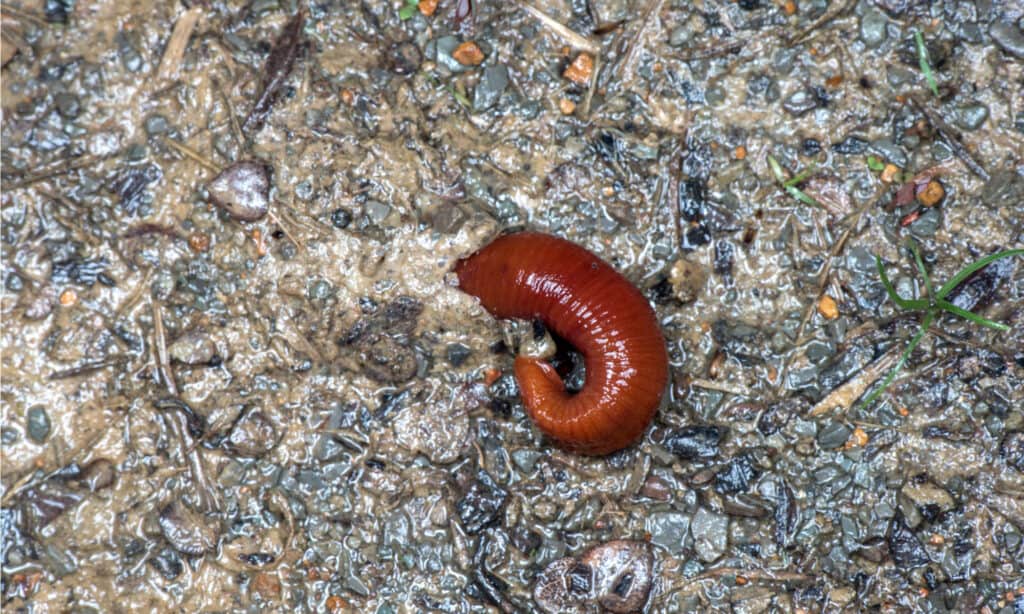
Kinabalu Giant Red Leech lives in damp leaves and soil.
©Norjipin Saidi/Shutterstock.com
Most types of leeches live in freshwater ponds and lakes. Their preferred habitat is a warm, slow-moving body of water. They don’t do well in swiftly moving streams or rivers. There are some saltwater leech species, but they mostly live in the ocean depths far from human habitation.
Although leeches prefer warm temperatures, they are extremely adaptable to their environment. They can go a long time without eating, and they will adjust their body temperature to their current environment. That’s why they are found everywhere except the freezing regions of Antarctica.
Diet
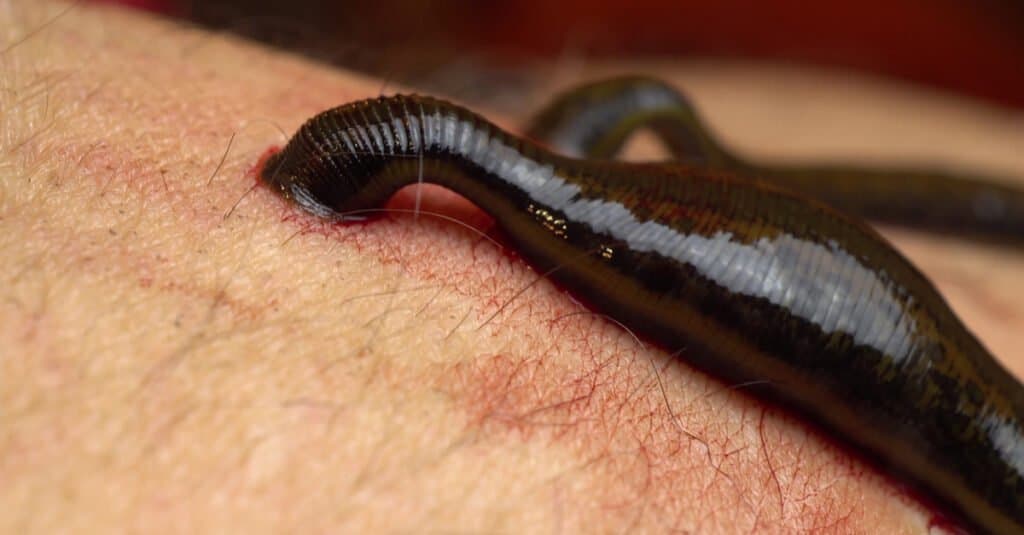
Despite their bloodsucking reputation, leeches have a varied diet.
©Vital9s/Shutterstock.com
Despite their bloodsucking reputation, leeches have a varied diet. While they do suck blood, freshwater leeches also eat mollusks, insects, insect larvae, fish eggs, and worms. When they suck blood, they prefer to suck the blood of other water creatures, including worms, snails, and fish.
Some types of leeches are scavengers who feed on dead animals and plants. Only a small percentage sucks the blood of mammals.
History and Evolution
While there are other parasitic animals in the world, the leech has evolved to be especially successful at feeding well and feeding undetected. The saliva of the leech is comprised of roughly thirty different elements, which tells us that it has been one of its most impressive adaptations. Leeches evolved over time to have saliva that numbs their hosts and also keeps the blood flowing freely.
Predators and Threats
Leeches are an important food source for fish, turtles, and ducks. Their population is stable and isn’t vulnerable to any threats. Any activities that harm pond life will harm all types of leeches.
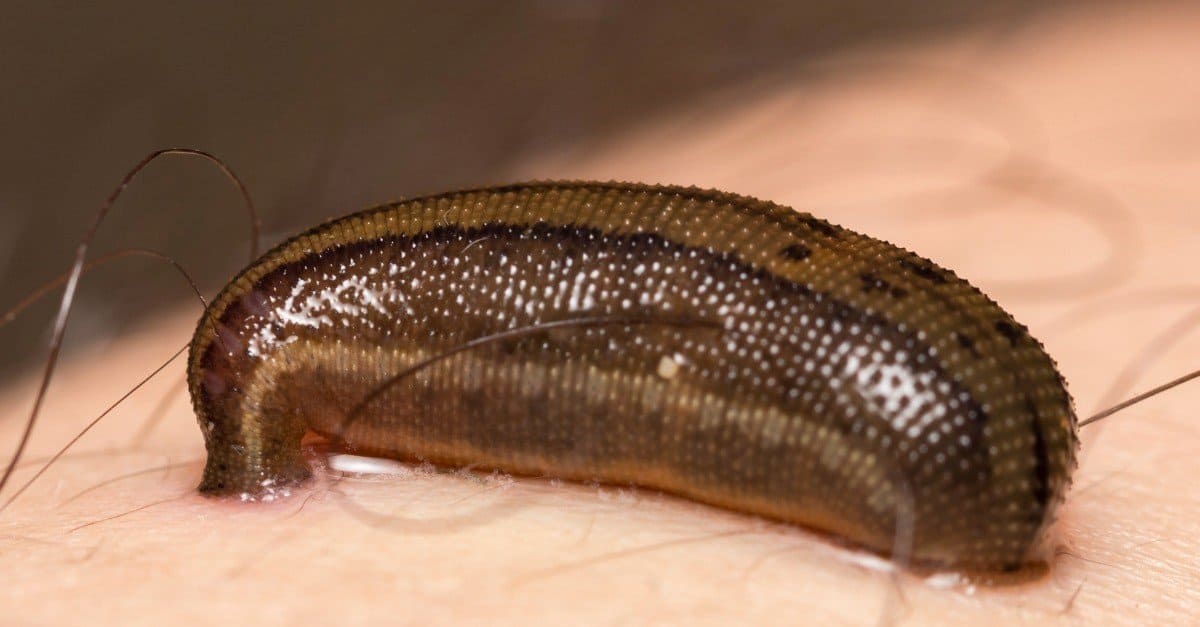
Leech populations are stable and aren’t vulnerable to any threats.
©iStock.com/kimetan
Reproduction and Life Cycle
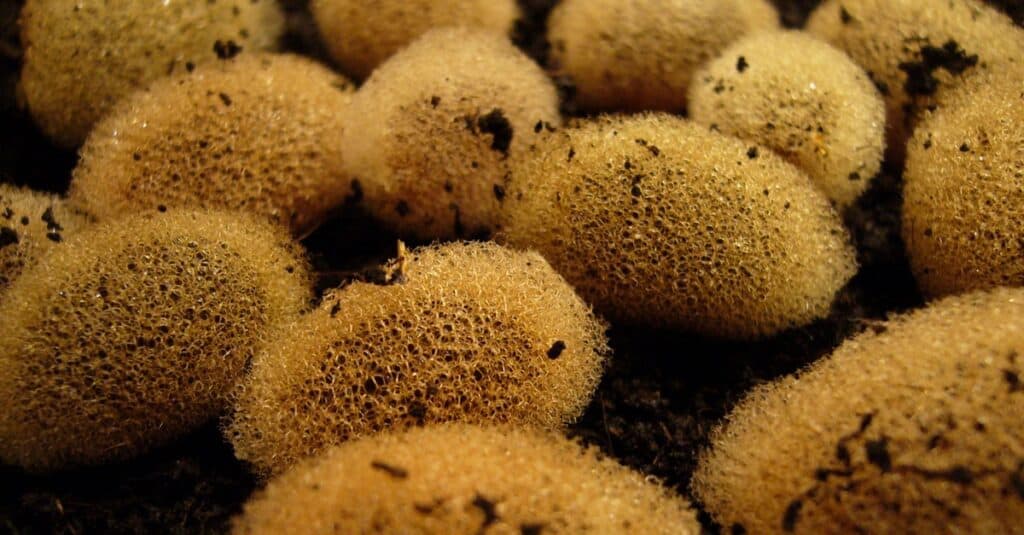
Baby leeches develop inside the cocoon.
©Ali Kiraz/Shutterstock.com
Leeches are hermaphrodites, and there are no differences between males and females. During reproduction, they use cross-fertilization. Once the leech’s eggs are fertilized, the female lays them in a cocoon. There may be anywhere from 1 to 300 eggs in the cocoon. The female then attaches the cocoon to a fixed place like a plant or stone.
Baby leeches develop inside the cocoon. Unlike moths and butterflies, which go through several stages in the cocoon, they develop to their full size. In some cases, the mother leech carries the cocoon on her body to protect it.
Development of the young inside the cocoon can take up to nine months. Leeches are born fully formed and ready to live on their own. They reach sexual maturity in two years.
Where do leeches live with regard to others of their kind? Leeches are solitary and only mingle with other leeches during reproduction.
Compared to many invertebrates, they have a long lifespan. They can live up to 10 years in the wild. Their lifespan in captivity is even longer.
Population
There are no estimates of leech populations in the world. They live in every part of the world except Antarctica, and their population is not threatened.
Likable Leeches?
We hope you’ve learned some interesting facts about these common, creepy but harmless animals. Like all animals, they play an important role in their ecosystems. They may not be lovable, but they’re not dangerous.
View all 98 animals that start with LLeech FAQs (Frequently Asked Questions)
What is a leech?
It is a large, dark worm related to an earthworm. Its preferred habitat is warm, slowly moving bodies of water. A leech is a predator and bloodsucking parasite.
Are leeches dangerous?
They are not dangerous, but finding one on your body can be unpleasant. Their bite isn’t painful because their saliva has an anesthetic. Unlike other biting insects, they don’t carry venom or diseases. You will bleed a lot because the anticoagulant in their blood prevents the blood from clotting. It’s not fun, but it’s not dangerous.
How do I remove a leech?
You may find one on your skin after you wade or swim in a pond or walk through a wetlands area. If you do, follow these steps:
1. Find the leech’s mouth, which is the smallest end of its body.
2. Slide your fingernail under the leech’s head toward its mouth, and push the head sideways. Some people use a piece of paper or a thin, flat piece of wood.
3. Pushing the mouth off is safer than pulling it off. Attempting to pull the leech off may tear your skin.
4. Pull the other end of the leech off.
5. Toss the leech away.
6. Wipe off the blood.
7. Wash the wound in warm, soapy water.
8. Apply antibacterial ointment, iodine, or hydrogen peroxide.
9. If the wound is bleeding, apply a bandage.
What does a leech do to humans?
It bites you and sucks your blood.
Leeches can be beneficial. Because of their tiny teeth, they are medically useful. Medicinal leeches are specific species that doctors use in surgical procedures and to treat certain diseases, including varicose veins, blood clots, and bacterial infections. The use of leeches in medicine is known as hirudotherapy.
Do leeches have 32 brains?
Not exactly. A leech has 32 segments, and each segment has its own part of the leech’s brain. It is a single brain divided among 32 body parts.
Should you remove leeches?
Yes, you should remove them.
Where do leeches live?
They mostly live in the shallow waters of lakes and ponds. Some live in jungle and wetland areas.
What are leeches attracted to?
They are attracted to all animals that bleed.
Can a leech live out of water?
Water leeches can’t, but land species can.
Are there any tips for identification of a leech?
Identification is easy if there is one clinging to you. For quick identification, look for two tapered ends with suckers. For exact identification, look for a bloodsucking mouth on one end.
Thank you for reading! Have some feedback for us? Contact the AZ Animals editorial team.
Sources
- The Knowledge Burro: What Does Hirudinea Mean? FactInformer: 20 Facts About Leeches. Healthline: What Is Leech Therapy?, Available here: https://theknowledgeburrow.com/what-does-hirudinea-mean-in-latin/
- FactInformer, Available here: https://factinformer.com/facts/82/about-leeches/#:~:
- Healthline, Available here: https://www.healthline.com/health/what-is-leech-therapy

